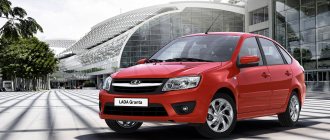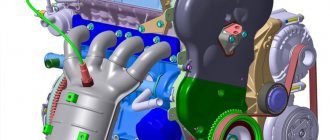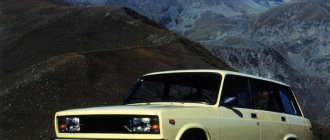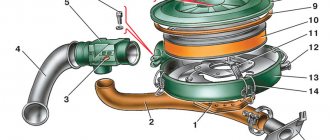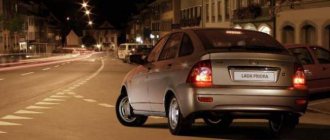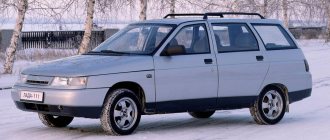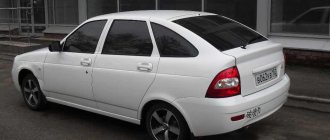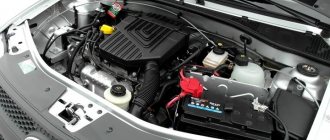Buyers of the VAZ-2111, as a rule, are people who quite often have to transport various cargoes. Accordingly, the first place here comes to such points as carrying capacity and luggage compartment capacity. However, sometimes potential buyers are interested in all the dimensions of the VAZ-2111 - a station wagon.
Some of the modifications of the “eleventh” differ in their sizes
Naturally, the VAZ-211 is considered by potential buyers as a passenger truck. The station wagon body allows you to “take on board”, including bulky cargo, which is simply impossible to stuff into a sedan, and can hardly be placed in a hatchback. However, sometimes potential buyers are interested in all the dimensions of the car - size can matter, for example, if you have a non-standard garage. So, let's look at the main characteristics of the “eleventh”. In particular:
- length - for almost all modifications it is 4,285 millimeters. The only exception here is the VAZ-2111 “Tarzan” with 1.7 and 1.8 liter engines. They are slightly shorter - 4,255 millimeters;
- the total width, including mirrors, is 1,680 millimeters for almost all modifications. "Tarzans" is also different here. They are slightly wider than the others - 1,710 millimeters;
- height – the situation is exactly the same here. For almost all modifications this parameter is 1,480 millimeters. “Tarzans” stands out here too. They are taller - 1,610 millimeters.
Reviews about the car
Among the main advantages, in addition to the versatility and technical characteristics of the VAZ-2111, car owners note:
- interesting design;
- high-quality head optics;
- a significant number of power units;
- affordable price;
- comfortable interior;
- permeability;
- overall reliability.
The main disadvantages are:
- low quality paintwork;
- poor sound insulation;
- assembly defects.
Thanks to the station wagon body, affordable price and high-quality technical characteristics, the VAZ-2111 has become the longest-running modification of the tenth family of Volga small cars.
Trunk of VAZ-2111
However, the main parameter of the “eleventh”, which is why car enthusiasts generally choose it, is, of course, its carrying capacity. Here the VAZ-2111 has practically no equal among the products of the domestic automobile industry. In this case, Largus should be taken out of the equation, since, firstly, it is a foreign car produced in Togliatti, and secondly, it is a slightly different class of car.
In the standard version, the volume of the luggage compartment of the “eleventh” is 380 liters. However, these are not all parameters.
For example, when loading a car to the ceiling, we already get 575 liters.
And finally, the most spacious option. We are talking about the folded rear seat. Here we already get a fairly solid result - 1,215 liters. At the same time, you can load 500 kilograms for transporting cargo. Now let's look at slightly different numbers. In particular, the total length of the luggage compartment is 1,630 millimeters. Another quite important parameter. The height of the rear door opening is 890 millimeters. And finally, let's look at the following parameters of the car. The width of the compartment between the wheel arches is 930 millimeters.
A rather interesting experiment was carried out by the publication “Behind the Wheel” back in 2000, when the VAZ-2111 was compared with the “nine”, “Svyatogor”, Izh-2126, GAZ-310221 and with the classic VAZ “four”. As a result, “eleventh” confidently took second place. The winner was the Volga, which, as is known, belongs to a higher class. Note that cubes of 5, 10 and 20 liters were used to test the trunk capacity.
If we talk about specific indicators, we get the following picture. First place - GAZ-310221, with a result of 1,510 liters. In second place, as already mentioned, is the VAZ “eleventh”. At the same time, the gap from the leader was quite decent - 1,215 liters. Well, “Svyatogor” took an honorable third place. Its indicator is 1,100 liters. The remaining 3 participants showed more modest results. In particular, all of them lacked 30 to 80 liters to reach the 1,000 mark.
At the same time, the VAZ-2111 is quite reliable and does not suffer from problems that are typical, for example, of Izhevsk cars. It also makes no sense to compare the first and second generations with Samara, since this series does not have a station wagon body. Accordingly, the “eleventh”, firstly, is more spacious, and secondly, it is still a modern model. Therefore, it still enjoys well-deserved popularity, especially in small towns. Therefore, if you need an inexpensive, reliable, and at the same time relatively inexpensive station wagon, better than the VAZ-2111, it is probably difficult to search for anything. Naturally, you can choose something more modern, but, of course, you will have to pay more for this.
Source
Poor quality fuel
The first thing you need to check is how high-quality the fuel was poured into the vehicle. If the gasoline was of poor quality, then most likely one of the elements of the fuel system was forgotten. So, the motorist will have to find out what the fuel supply scheme is and find parts that could have failed.
So, the first element that comes under scrutiny is the spray nozzles. Malfunctions of the injectors can cause unstable operation of the engine, which will lead to tripping. A special stand is used to diagnose and clean the unit, but many motorists carry out the process themselves, using carburetor cleaning fluid.
Also, unstable engine operation may be caused by clogged fuel filters. One is located under the rear right wheel, and the second is in the fuel pump. There is a filter mesh on the fuel pump intake that needs to be replaced. The process is quite complicated, since you have to remove the rear seats and remove the fuel supply element. But the fuel filter under the wheel can be changed quickly and without any problems.
Characteristics of VAZ 2111
VAZ 2111 is a popular domestic car with a station wagon body. The car began to be produced in 1998 at the AvtoVAZ plant, and from 2009 to 2014 - at the Ukrainian plant. The VAZ 2111 is ideal for city trips, as well as for travel in extreme conditions. The car is equipped with a 1.5 liter injection engine, fuel consumption is 10.1 l/100 km (average 7.5 l). The steering is equipped with a hydraulic booster, and the fuel tank has a volume of 43 liters, similar to the VAZ 2110.
The most important advantage of the VAZ 2111 is the smooth ride of the car, a large trunk and high stability on any surface. The car is equipped with a high-power automatic heater, which allows you to feel comfortable in the most severe frosts.
Technical parameters of VAZ 2111
| Engine | 1.6 l, 8kl (Euro-2) | 1.6 l, 8kl (Euro-3) | 1.6 l, 16cl (Euro-3) |
| Length, mm | 4285 | 4285 | 4285 |
| Width, mm | 1680 | 1680 | 1680 |
| Height, mm | 1480 | 1480 | 1480 |
| Base, mm | 2492 | 2492 | 2492 |
| Front wheel track, mm | 1410 | 1410 | 1410 |
| Rear wheel track | 1380 | 1380 | 1380 |
| Load capacity, kg | 400 | 400 | 400 |
| Luggage compartment volume, dm3 | 426 | 426 | 426 |
| Weight in running order, kg | 1055 | 1055 | 1055 |
| Gross vehicle weight, kg | 1550 | 1550 | 1550 |
| Permissible total weight of a towed trailer with brakes, kg | 1000 | 1000 | 1000 |
| Permissible total weight of a towed trailer without brakes, kg | 500 | 500 | 500 |
| Wheel formula / drive wheels | 4x2 / front | ||
| Car layout diagram | front-wheel drive, front engine, transverse | ||
| Body type / number of doors | station wagon/5 | ||
| engine's type | injection gasoline, four-stroke | ||
| Engine displacement, cm3 | 1596 | 1596 | 1596 |
| Supply system | distributed injection with electronic control | ||
| Number and arrangement of cylinders | 4, in-line | ||
| Maximum power, kW/rev. min. | 59 / 5200 | 65,5 / 5000 | 65,5 / 5000 |
| Maximum torque, Nm at rpm | 120 / 2700 | 131 / 3700 | 131 / 3700 |
| Maximum speed, km/h | 165 | 175 | 175 |
| Fuel consumption by driving cycle, l/100 km | 7,5 | 7,5 | 7,5 |
| Fuel | AI-92 (min) | AI-92 (min) | AI-92 (min) |
| Transmission | mechanical | ||
| Number of gears | 5 forward, 1 reverse | ||
| Main gear ratio | 3,7 | 3,7 | 3,7 |
| Steering | with hydraulic booster, rack and pinion steering mechanism | ||
| Tires | 175/65 R13 175/65 R14 185/60 R14 | 175/65 R13 185/60 R14 | 175/65 R14 185/60 R14 |
| Fuel tank capacity, l | 43 | 43 | 43 |
Length
The geometry of the VAZ 2110 body is described in the operating instructions. The main parameters for checking body geometry are as follows:
- There should be 4.265 meters between the extreme points of the front bumper and the rear bumper.
- The distance between the center of the front wheel and the center of the corresponding rear wheel is 2.492 meters.
- The distance from the center of the front wheel to the end point of the front bumper is 0.829 meters.
- The distance from the center of the rear wheel to the end point of the rear bumper should be 0.944 meters.
Engine chip tuning circuit
Not many car enthusiasts can boast of a powerful 2110 engine. Thus, to improve the power characteristics of the engine, it is necessary to carry out chip tuning of the VAZ 2110. To do this, they usually turn to specialists, but more and more vehicle owners are doing the process themselves.
The chip tuning scheme is quite simple. To perform the operation yourself, you will need an OBD II cable (USB-Auto), a laptop computer and software. It is worth remembering that there are three options for modifying the power unit: for power (but this will increase consumption), for reducing consumption (leading to a loss of power) and balanced (balance between the optimal indicators of consumption and power).
Typically, chip tuning of a VAZ 2110 is done with the aim of reducing fuel consumption, therefore, if the owner of the car decides to do it himself, then it is necessary to select the appropriate software. But, it is recommended not to take risks and turn to professionals for help.
Modifications of VAZ 2111
- LADA-21110 (VAZ-21110) - 8-valve 1.5-liter 2111 engine with distributed fuel injection producing 77 hp;
- LADA-21111 (VAZ-21111) - 8-valve 1.5-liter 2110 engine with a carburetor producing 72 hp;
- LADA-21112 (VAZ-21112) - 8-valve 1.6-liter engine 21114 with distributed fuel injection with a power of 82 hp;
- LADA-21113 (VAZ-21113) - 16-valve 1.5-liter 2112 engine with distributed fuel injection producing 93 hp;
- LADA-21114 (VAZ-21114) - 16-valve 1.6-liter engine 21124 with distributed fuel injection with a power of 89 hp;
- LADA-21116 (VAZ-21116-04) - 16-valve 2.0-liter Opel C20XE engine with 150 hp, all-wheel drive;
- VAZ 2111-90 “Tarzan 2” is a five-door SUV, produced from 1999 to 2006.
Front-wheel drive station wagon
The first car of the VAZ-2111 model rolled off the assembly line of the Volzhsky Automobile Plant in 1998. He was a representative of the new front-wheel drive tenth model family, designed to replace outdated classic cars in the company's production line. It should be noted that the VAZ-2111 became the first serial domestic station wagon with front-wheel drive.
Another distinctive feature of the tenth family is the fact that the company’s designers developed several modifications at once, and therefore the technical characteristics of the VAZ-2111 are very similar to those of its classmates in the following version:
- sedan - 2110 (produced from 1997 to 2010);
- five-door hatchback – 2112 (1998-2011);
- three-door hatchback – 2123 (2002-2009).
Geometry check
Here are four main types of measurements that will allow you to make sure that the car has not been in an accident and has the parameters you need:
- Reconciliation of diagonals. Before proceeding with detailed calculations, you should make two simple measurements that will immediately identify the problem. The car needs to be measured diagonally on both sides. If the measurement results coincide (with an accuracy of a millimeter), this will mean that the body as a whole has the correct shape. But we should not stop at these two dimensions.
- Checking the height of the racks. To take this measurement, you need to measure the height of the racks in four places. It is important to take measurements from the front and rear, as well as from both sides of the machine. The four indicators must match.
- Identification of a distorted roof plane. To find out if your car's lid is in place, take measurements from the door diagonals. You need to measure from the bottom rear corner of the door to the top front corner, and vice versa. If the indicators coincide on both sides, good. Just in case, it’s worth checking the roof diagonals.
- Determining the correct location of the front glass. Contrary to popular belief, even if the windshield fits correctly, its geometry can be distorted. Therefore, be sure to compare the lengths of the diagonals of this part.
As a rule, problems with mismatched machine parameters arise after road accidents. However, this does not happen 100% of the time.
Welding or other repairs that involve heating the metal can affect the physical parameters of the vehicle. Therefore, each time take the above measurements after the car has been to the auto repair shop.
Buyers of the VAZ-2111, as a rule, are people who quite often have to transport various cargoes. Accordingly, the first place here comes to such points as carrying capacity and luggage compartment capacity. However, sometimes potential buyers are interested in all the dimensions of the VAZ-2111 - a station wagon.
Interior
The “inner world” of the Lada 2111 is rather meager by modern standards. But for a car whose design was developed in the 90s, the interior is decent. The general appearance of the dashboard and instrument console looks original. Before the release of 2110 and 2111, VAZ did not implement anything like this. Stepwise transitions of lines are observed. Finishing plastic has a rough structure. This adds reliability both visually and in feel.
The interior design, as well as the exterior, is dominated by classics. The rectangular shapes of all elements and the original arrangement of buttons on the panel behind the steering wheel stand out. The speedometer and instrument panel are generally ergonomically located, and the upper half of the steering wheel is empty. This makes reading instrument readings very convenient. The steering wheel is borrowed from the Lada Samara. Overall, the interior is comfortable and spacious; an additional 430 dm3 of space is added by a spacious trunk.
A crash test of the VAZ 2111 showed that in a frontal collision at a speed of 50 km/h, belted passengers remain safe from impact. But heavy objects located in the cabin and on top of the trunk can injure people due to inertia.
Modifications
| Name | Year of issue | |
| LADA 111 (2111) 1.5 | 01.1996 — 12.2005 | Characteristics |
| LADA 111 (2111) 1.5 16V | 01.1995 — 08.2002 | Characteristics |
| LADA 111 (2111) 1.5 | 10.2000 — 12.2005 | Characteristics |
| LADA 111 (2111) 1.5 16V | 10.2000 — 12.2005 | Characteristics |
| LADA 111 (2111) 1.6 | 09.2004 — 12.2013 | Characteristics |
| LADA 111 (2111) 1.6 | 09.2004 — | Characteristics |
Body dimensions VAZ 2111 - Dimensions tables
| 2111 1.5 MT (1997 - 2004) | ||
| Number of doors | 5 | |
| Number of seats | 5 | |
| Wheelbase | 2492 mm | |
| Front track | 1400 mm | |
| Rear track | 1370 mm | |
| Ground clearance | 160 mm | |
| Trunk volume is minimal | 450 l | |
| Maximum trunk volume | 1420 l | |
| Width | 1680 mm | |
| Length | 4285 mm | |
| Height | 1480 mm | |
| 2111 Tarzan 1.7 MT 4WD (1999 - 2006) | ||
| Number of doors | 5 | |
| Number of seats | 5 | |
| Wheelbase | 2585 mm | |
| Front track | 1470 mm | |
| Rear track | 1470 mm | |
| Ground clearance | 160 mm | |
| Trunk volume is minimal | 450 l | |
| Maximum trunk volume | 1420 l | |
| Width | 1710 mm | |
| Length | 4255 mm | |
| Height | 1610 mm | |
| 2111 Tarzan 1.8 MT 4WD (1999 - 2006) | ||
| Number of doors | 5 | |
| Number of seats | 5 | |
| Wheelbase | 2585 mm | |
| Front track | 1470 mm | |
| Rear track | 1470 mm | |
| Ground clearance | 160 mm | |
| Trunk volume is minimal | 450 l | |
| Maximum trunk volume | 1420 l | |
| Width | 1710 mm | |
| Length | 4255 mm | |
| Height | 1610 mm | |
| 21111 1.5 MT (1997 - 2003) | ||
| Number of doors | 5 | |
| Number of seats | 5 | |
| Wheelbase | 2492 mm | |
| Front track | 1400 mm | |
| Rear track | 1370 mm | |
| Ground clearance | 160 mm | |
| Trunk volume is minimal | 450 l | |
| Maximum trunk volume | 1420 l | |
| Width | 1680 mm | |
| Length | 4285 mm | |
| Height | 1480 mm | |
| 21112 1.6 MT (2004 - 2009) | ||
| Number of doors | 5 | |
| Number of seats | 5 | |
| Wheelbase | 2492 mm | |
| Front track | 1400 mm | |
| Rear track | 1370 mm | |
| Ground clearance | 160 mm | |
| Trunk volume is minimal | 450 l | |
| Maximum trunk volume | 1420 l | |
| Width | 1680 mm | |
| Length | 4285 mm | |
| Height | 1480 mm | |
| 21113 1.5 MT (2004 - 2009) | ||
| Number of doors | 5 | |
| Number of seats | 5 | |
| Wheelbase | 2492 mm | |
| Front track | 1400 mm | |
| Rear track | 1370 mm | |
| Ground clearance | 160 mm | |
| Trunk volume is minimal | 450 l | |
| Maximum trunk volume | 1420 l | |
| Width | 1680 mm | |
| Length | 4285 mm | |
| Height | 1480 mm | |
| 21113 1.5 MT (1997 - 2004) | ||
| Number of doors | 5 | |
| Number of seats | 5 | |
| Wheelbase | 2492 mm | |
| Front track | 1400 mm | |
| Rear track | 1370 mm | |
| Ground clearance | 160 mm | |
| Trunk volume is minimal | 450 l | |
| Maximum trunk volume | 1420 l | |
| Width | 1680 mm | |
| Length | 4285 mm | |
| Height | 1480 mm | |
| 21114 1.6 MT (2000 - 2009) | ||
| Number of doors | 5 | |
| Number of seats | 5 | |
| Wheelbase | 2492 mm | |
| Front track | 1400 mm | |
| Rear track | 1370 mm | |
| Ground clearance | 160 mm | |
| Trunk volume is minimal | 450 l | |
| Maximum trunk volume | 1420 l | |
| Width | 1680 mm | |
| Length | 4285 mm | |
| Height | 1480 mm | |
| 21114 1.6 MT (2000 - 2009) | ||
| Number of doors | 5 | |
| Number of seats | 5 | |
| Wheelbase | 2492 mm | |
| Front track | 1400 mm | |
| Rear track | 1370 mm | |
| Ground clearance | 160 mm | |
| Trunk volume is minimal | 450 l | |
| Maximum trunk volume | 1420 l | |
| Width | 1680 mm | |
| Length | 4285 mm | |
| Height | 1480 mm | |
| Bogdan 1.6 MT (2009 - present) | ||
| Number of doors | 5 | |
| Number of seats | 5 | |
| Wheelbase | 2492 mm | |
| Front track | 1400 mm | |
| Rear track | 1370 mm | |
| Ground clearance | 160 mm | |
| Trunk volume is minimal | 450 l | |
| Maximum trunk volume | 1420 l | |
| Width | 1680 mm | |
| Length | 4285 mm | |
| Height | 1480 mm | |
| Bogdan 1.6 MT (2009 - present) | ||
| Number of doors | 5 | |
| Number of seats | 5 | |
| Wheelbase | 2492 mm | |
| Front track | 1400 mm | |
| Rear track | 1370 mm | |
| Ground clearance | 160 mm | |
| Trunk volume is minimal | 450 l | |
| Maximum trunk volume | 1420 l | |
| Width | 1680 mm | |
| Length | 4285 mm | |
| Height | 1480 mm | |
Linear dimensions of the VAZ and exterior
The dimensions of all VAZ cars of this model are almost the same:
- length - 4.285 m;
- width - 1.68 m;
- height - 1.48 m;
- rear track - 1.37 m;
- front track - 1.4 m;
- wheelbase - 2.492 m;
- weight - 1050 kg;
- driving pair of wheels - front;
- number of doors - 4;
- seats - 5;
- body type - station wagon.
Newer modifications 21112, 21113, 21114 have ground clearance of 165 mm, while the first versions of the station wagon have ground clearance of 160 mm. There are three types of tires: 175/70R13, 175/65R14 and 185/60R14. The tire size is affected by the configuration. The first number indicates the width of the tire, the second is the percentage of the tire profile to the width. The designation R indicates that the tire type is radial. The last number is equal to the mounting diameter of the disk in inches.
The appearance of the 111th Lada is nice. The body is created on the platform of the 2110 sedan, the appearance of which was the result of a complete restyling of models of previous years. The line of cars 2110, 2111 can be safely called the first modern cars made by AvtoVAZ.
Streamlining has been improved, new narrow headlights have been introduced. The car has a “lanky” shape in profile. The radiator grille and air intake are separated by a license plate; there are no bulges along the entire perimeter of the body. The side “skirts” are trimmed with black plastic, and in some modifications the bumpers are also trimmed.
The design of this model is classic, and when painted in any color, the VAZ looks solid.
Technical specifications
For the new station wagon, at the initial stage of production, the VAZ-2111 engine model with technical characteristics was considered the base one:
- type – four-stroke;
- fuel - gasoline (AI-92, AI-95);
- cooling – liquid;
- number of cylinders – 4;
- location – in-line;
- number of valves – 8;
- volume – 1.50 l;
- power – 78.0 l. With.;
- cylinder diameter – 8.20 cm;
- piston stroke – 7.10 cm.
The features of this power unit include a gasoline injection system for mixture formation.
Technical characteristics of the VAZ-2111 station wagon with the base engine are:
- passenger capacity – 5 people;
- number of doors – 5;
- trunk volume – 445 l (with the rear row of seats folded – 1425 l);
- total weight – 1.04 t;
- drive – front;
- Gearbox – mechanical (5-speed);
- wheelbase - 2.49 m;
- ground clearance - 16.0 cm;
- length – 4.29 m;
- width – 1.68 m;
- height – 1.40 m;
- turning radius – 5.20 m;
- maximum speed – 161 km/h;
- acceleration (100 km/h) – 14.0 sec;
- wheel size – 175/70R13.
From the history
(export name Lada 111
) - the first front-wheel drive VAZ station wagon, mass-produced since the end of 1998.
The development of the VAZ-2111 model was carried out in parallel with the base VAZ-2110.
It all started in 1985 with the search for the shape of the rear.
Layout of the 100 series in two versions. The left half was made by A. Ruzanov, the right half by S. Zaitsev (1986).
During testing, the
station wagon
had a hard time on the cobblestones - 500 kg of load is no joke.
There were problems with the spars. There were a lot of problems with the trunk shelf. From the very beginning, the shelf rose when the back door was opened. There was a problem on the station wagon
with the rear seat mount.
Full-scale plasticine model of a station wagon based on the 100a series. 1987
Noteworthy are the original door handles built into the glass next to the stacked windows. Didn't pass - difficult to manufacture.
Regarding the “hundred-gram windows,” experts from Belgium said that a sunroof would definitely be needed, or better yet, an air conditioner so that people would not feel discomfort.
On the 200 series a sunroof appeared. Although it was welcomed, and there was a trend and fashion in those years, the plant did not yet have experience with it, the technology had not been developed, so the hatch had to be abandoned.
We tried something else - a fixed front window (and, in fact, this can no longer be called a window, since it did not open), and behind it - an ordinary sliding glass. This pseudo-window had a spherical shape so that the difference between the surface and the glass was minimal. All this is for better aerodynamics.
Later, the original hundred-gram windows were removed. To begin with, the front door glass was divided into two halves. The front part, made of spherical glass, was rigidly fixed (for better aerodynamics), and the rear part was lowering. All the glass at the rear side door rolled down.
In 1997, a pilot production batch of VAZ-2111 was produced. The body was made at SKP, the car was driven along the conveyor belt, and the entire rear part was assembled at the OPP. It was like this for about a year. Since 1998, the station wagon has been completely assembled.
Chronology
- appeared already at the beginning of 1989. 11 VAZ-2111 units were produced. All tests required by technical specifications and regulatory documents were carried out.
— manufactured in 1993–94. 16 VAZ-2111 units were produced.
- manufactured in 1994 - 95. 2 VAZ-2111 units were produced.
— was produced in 1995. Mass experimental-industrial batch. 2 VAZ-2111 units were produced.
Description
The engine on this car can be used in one of two options: with electronically controlled multipoint injection (each cylinder has its own injector) and an electronic ignition system. The 1.5-liter engine with 8 valves provides sufficient power (56 kW) and torque (118 Nm) with moderate fuel consumption. The engine has a displacement of 1.5 liters, with 16 valves, a twin-shaft cylinder head, providing increased power (69 kW) and torque (130 Nm), allowing the car to have improved dynamic qualities. All station wagons are equipped with a “short” main gear (3.9 instead of 3.7 in the VAZ-2110). With a total weight increased by 20 kg, the smoothness of the ride has even increased compared to the sedan.
The VAZ-2111 is available in three modifications - the basic 2111 with an injection engine, 21111 with a carburetor engine, and 21113 with a sixteen-valve engine and 14-inch wheels. Basic VAZ-2111 (VAZ-21102 sedan) with a 1.5-liter VAZ-2111 engine; VAZ-21111 with a conventional 1.5-liter VAZ-21083 engine; VAZ-21113 with a 16-valve VAZ-2112 power unit and improved brakes (analogous to the VAZ-21103 sedan).
The VAZ-2111-90 “Tarzan 2” is an all-wheel drive vehicle with a 4x4 wheel arrangement. The power unit, transmission and chassis are used from the VAZ-21213. “Tarzan 2” combines the comfort and convenience of the VAZ-2111 and the cross-country ability of Niva vehicles.
The following versions are available - “standard” (VAZ-21110-00 and VAZ-21113-00), “norm” (VAZ-21110-01 and VAZ-21113-01) and “luxury” (VAZ-21110-02 and VAZ -21113-02).
No frills
The Russian station wagon looks quite attractive from some angles, especially its front part - with nice headlights and a laconic radiator grille.
However, the heavy rear introduces serious disharmony into the appearance of the car - it “squats” to the ground even when the interior is unloaded, and when fully loaded it completely outweighs the front end.
Despite the acceptable ground clearance of 175 millimeters, you should be careful when driving on bumpy terrain. The reason lies, again, in the low overhang of the stern.
Familiar motives
The architecture of the front panel is completely identical to that of the VAZ 2110. The instrument panel looks simple, but is perfectly readable due to the large digitization and green backlight.
The trip computer, which is located on the center console, provides an indication of unlocked doors and warning lamps, and a clock is installed to the right of it. The air conditioning system has intuitive and clear controls, but the sound of its fan is very intrusive.
The driver's seat with a flat profile and weak lateral support distributes body weight unevenly, which is why the limbs may become numb and discomfort may appear in the back on a long journey.
Moreover, the range of seat adjustment in the longitudinal direction will seem insignificant for a tall driver. It’s also a bit cramped on the back sofa - if you’re 180 centimeters tall, you’ll have to accept the fact that your knees will have to be spread apart so as not to rest against the backs of the front seats.
The luggage compartment volume is 423 liters - not the most outstanding figure. However, when folding the second row seats, you can achieve a quite acceptable 1420 liters.
